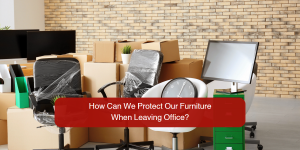
Relocating an office is a complex task that requires meticulous planning and execution. One of the most crucial aspects of this process is ensuring the safety of office furniture. Proper handling can prevent damage and save costs in the long run. Here are some essential tips to protect your furniture when leaving an office.
1. Plan and Inventory Your Furniture
Create a Detailed Inventory: Begin by listing all the furniture pieces in your office. This includes desks, chairs, cabinets, shelves, and other items. An inventory helps you keep track of each item and assess its condition before and after the move.
Assess the Condition: Note the current condition of each furniture piece. This will help you identify any pre-existing damage and ensure that any new damage during the move is recorded and addressed.
Plan the Layout: Have a clear plan for the layout of your new office space. This will help you decide which furniture pieces are essential and where they will be placed, ensuring a smooth transition.
- Disassemble Larger Furniture
Disassemble When Possible: Large furniture pieces such as desks and cabinets should be disassembled if possible. This makes them easier to transport and reduces the risk of damage.
Label Parts and Screws: Keep all screws, bolts, and small parts in labeled bags. Label each part of the furniture to make reassembly easier. This ensures that nothing gets lost during the move.
Follow Manufacturer’s Instructions: Refer to the manufacturer’s guidelines for disassembly and reassembly. This helps prevent damage due to improper handling.
3. Use Proper Packing Materials
High-Quality Packing Materials: Invest in high-quality packing materials such as bubble wrap, moving blankets, and sturdy boxes. These materials provide a cushion and protect your furniture from scratches and dents.
Wrap and Protect: Wrap each piece of furniture individually. Use bubble wrap for fragile items and moving blankets for larger pieces. Secure the wrapping with packing tape to ensure it stays in place during transit.
Use Furniture Pads: Place furniture pads or corner protectors on sharp edges to prevent damage. These pads also protect walls and doorways from scratches during the move.
4. Hire Professional Movers
Choose Reputable Office Movers: Hiring a professional office moving company can make a significant difference. Professional movers have the experience and equipment necessary to handle office furniture safely.
Check Credentials: Ensure that the moving company is licensed and insured. This protects you in case of any damage during the move.
Get a Detailed Quote: Obtain a detailed quote that outlines the services provided and any additional costs. This helps you budget effectively and avoid any hidden fees.
- Prepare Furniture for Transport
Clean and Empty Furniture: Clean all furniture before the move. Empty desks, cabinets, and shelves to make them lighter and easier to handle.
Secure Moving Parts: Secure any moving parts such as drawers and doors with tape or rope. This prevents them from opening and causing damage during transport.
Use Proper Lifting Techniques: Ensure that heavy items are lifted properly to avoid injury. Use dollies and lifting straps to assist with heavy or awkward pieces.
6. Store Furniture Properly If Needed
Climate-Controlled Storage: If you need to store your furniture temporarily, choose a climate-controlled storage facility. This prevents damage from extreme temperatures and humidity.
Elevate Furniture: Keep furniture off the ground by placing it on pallets or shelving units. This protects it from potential water damage and makes it easier to access.
Cover and Protect: Cover stored furniture with moving blankets or plastic wrap to protect it from dust and dirt. Ensure that the storage area is clean and dry.
7. Reassemble and Inspect Furniture at the New Office
Careful Reassembly: Take your time to reassemble furniture carefully, following the labeled parts and instructions. Rushing this process can lead to damage.
Inspect for Damage: Inspect each piece of furniture for any damage that may have occurred during the move. Report any issues to the moving company immediately.
Arrange and Organize: Place the furniture according to your planned layout. Ensure that everything is properly positioned and secure.
Office Movers: Your Best Option for a Smooth Transition
Why Hire Office Movers? Professional office movers specialize in handling office relocations. They have the expertise to manage the entire process, from disassembly to reassembly, ensuring your furniture is well-protected throughout the move.
Benefits of Using Office Movers:
- Efficiency:Office movers work quickly and efficiently, minimizing downtime for your business.
- Safety:They use proper equipment and techniques to handle heavy and delicate furniture, reducing the risk of damage.
- Insurance:Professional movers are insured, providing you with peace of mind in case of any accidents.
Hiring an office moving company not only protects your furniture but also ensures a smooth and stress-free transition to your new office space.
By following these tips, you can protect your office furniture and ensure it arrives at your new location in excellent condition. A well-planned move minimizes disruptions and allows you to focus on settling into your new office environment.
Information contained on this page is provided by an independent third-party content provider. Binary News Network and this Site make no warranties or representations in connection therewith. If you are affiliated with this page and would like it removed please contact [email protected]



Comments